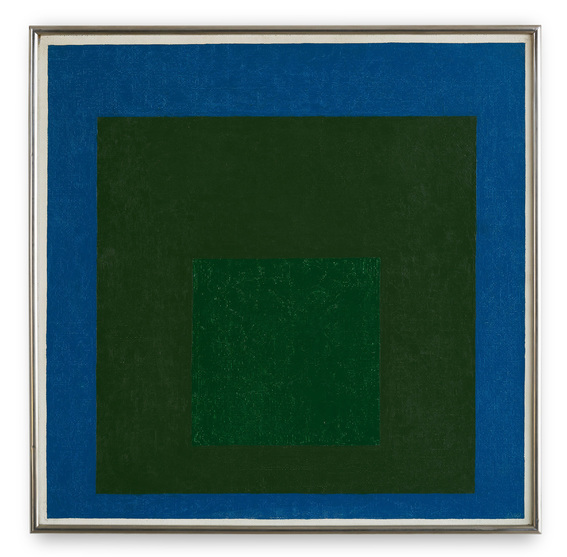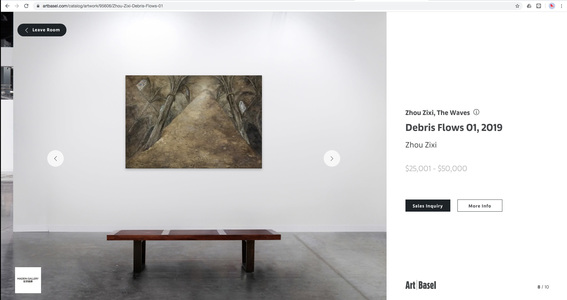
R
E
V N
E
X
T
*Last updated Monday, March 30, 2020.
Art Basel Hong Kong’s (ABHK) first online version of the fair, which concluded on March 25 at 6pm local time, was an IRL check on the art market at the beginning of a new decade—not all bad, but not that great for most galleries either. The digital art world mirrors the bigger picture in the art world at large, as mega galleries reported high-profile sales of investment-grade artists, while mid-size and regional galleries struggled to find buyers for lesser-known names—despite many saying they received more interest than they had expected. No one imagined that the “Online Viewing Rooms," or OVR, would replace the real ABHK, originally scheduled for March 19–21 before Covid-19 forced organizers to call off the actual fair. In the end, over the course of the digital version’s run from March 18 to 25, more than 250,000 virtual visitors ended up looking through the 2,000-plus .jpgs of works shown in the Online Viewing Rooms of 235 galleries, roughly 90 percent of the fair’s original participants. The prevailing sentiment from galleries seemed to be that what sales or contacts were made was better than nothing at all, with more of the world going into lockdown due to Covid-19 and a global recession looming.
Several mega players claimed to have fared well, especially those galleries with prior experience on virtual platforms. David Zwirner (New York / London / Paris / Hong Kong) boasted about the gallery selling more than USD 6.2 million in art through the Art Basel OVR and its own online viewing platform, including a Marlene Dumas painting for USD 2.6 million, a Luc Tuymans for USD 2 million, and several other six-figure works including a Liu Ye painting for USD 500,000.
Iwan Wirth, president of Hauser & Wirth (London / Somerset / New York / Los Angeles / Zürich / St. Moritz / Gstaad / Hong Kong), reported sales of several works, including a USD 600,000 oil canvas by Josef Albers, Study for Homage to the Square: Late Silence (1960), as well as three works by Paul McCarthy in the range of USD 270,000–300,000. In a press release, Wirth said he was happy with the results: “Honestly, I think we’ve done quite well given the circumstances. We had no presales and only a few enquiries last week.” Wirth noted that the online platforms had served the gallery well: “We’re seeing more engagement from Asia come through both our own and Art Basel’s platforms. . . Much is being said about digital: it is just the new norm. We’ve done it for years and it shows.”
Directors at rival mega galleries were also quick to boast of their experiences with online platforms. Nick Simunovic, managing director of Gagosian Hong Kong (New York / Beverly Hills / San Francisco / London / Paris / Geneva / Basel / Rome / Athens / Hong Kong), attributed the gallery’s success in the ABHK online venture to the fact that it has been hosting its own online viewing rooms since 2018, and to its offering what he described as “highly in-demand primary market pieces straight from the artists’ studios.” Simunovic praised ABHK for shifting its platform online, saying that it was “inevitable but the current moment created a real urgency for everyone.” Within the first few days, Gagosian sold, among others, Georg Baselitz’s oil-on-canvas Die andere Seite vom Ölfleck (2019), priced at USD 1.3 million, and Mary Weatherford’s USD 750,000 mixed-media painting with neon tubes, Splendor in the Grass (2019).
Similarly positive about the direction of online sales was Almine Rech-Picasso, owner of Almine Rech Gallery (Paris / Brussels / London / New York / Shanghai), who told AAP: “’While the digital will never replace the physical experience of seeing art at exhibitions and art fairs, I was very pleased . . . and look forward to harnessing this new tool further in the future as online platforms and new technologies become increasingly important to the global art market.” The gallery moved several high-value works, including one by George Condo in the range of USD 500,000–1 million, and one by Rudolf Polanszky in the range of USD 50,000–100,000.
Emma Son, senior director at Lehmann Maupin (New York / Hong Kong / Seoul), also enjoyed the alternative, saying that it “allows the audience more freedom and flexibility to browse the works for a longer time, while the price transparency and easy access create a welcoming environment especially for new collectors or people who otherwise don’t have the opportunity to visit the physical fair.” The gallery has decided to embrace the digital format and will launch their own online viewing rooms today.
London’s Sadie Coles HQ sold several works displayed in the ABHK online viewing room, as well as others not shown online but offered privately as a result of conversations that the online works generated; interested clients reportedly included a major museum. Also positive about the week’s results was Willem Molesworth, director of Hong Kong-based de Sarthe Gallery, who was working to close transactions of works by both of the young artists shown in the gallery’s presentation, Beijing-based painter Zhong Wei and Hong Kong artist Mak Ying Tung 2, as well as fielding inquiries from new contacts made with the platform. Molesworth commented to AAP that “The Online Viewing Rooms have been very good for us.” Nick Yu of Hong Kong’s Blindspot Gallery said the Online Viewing Rooms had surpassed admittedly modest expectations, and reported sales of multiple works by multidisciplinary artist Trevor Yeung and photographer Pixy Liao to a private European foundation.
Several galleries did not find the digital platform as useful but nevertheless made sales during the week. Kuala Lumpur-based Richard Koh Fine Art, for instance, did not sell anything directly from the online viewing rooms but Koh told AAP that the gallery found takers for works shown at its recent solo exhibition of Yeoh Choo Kuan from its existing client pool. Edouard Malingue Gallery (Hong Kong / Shanghai) likewise made sales to existing clients, who, according to co-founder Lorraine Malingue, “did not access the works via Online Viewing Room.” Nonetheless, the gallery reported strong interest from people viewing the platform. Meanwhile, Mumbai’s Jhaveri Contemporary shared that it had closed deals with one existing collector and one new client, the latter not through the online viewing rooms.
For Perrotin (Paris / Hong Kong / New York / Seoul / Tokyo / Shanghai) the experience is galvanizing a new digital approach to sales. Alice Lung, partner at Perrotin, confirmed most sales not through the online rooms but to “existing clients with whom we have very good relationships.” However, the gallery was optimistic about the potential to reach new buyers after it “started conversations with new connections who contacted us through the platform.” Perrotin’s first time participating in a virtual art fair, Lung said, was “an instructive learning experience which will be taken into consideration as we review our long-term development plans concerning the gallery’s digital strategy and offerings.”
Others, including Hong Kong’s Hanart TZ Gallery and Bangkok CityCity Gallery, found the online platform challenging, reporting no sales yet when approached by AAP, despite numerous inquiries from the online platform. Manila-based Silverlens said it is waiting to confirm a sale of a Patricia Perez Eustaquio work but to a pre-existing client, while MadeIn Gallery (Shanghai) also reported some inquiries but slow sales for their solo presentation of Zhou Zixi. Madein Gallery’s Ivy Zhou remarked to AAP that the gallery staff nonetheless thought “[Art] Basel did an amazing job to launch this online platform at this special moment; we all understand it’s not that easy.”
Although the online alternative was inevitable given the current circumstances, some questioned the features and presentation of the platform. Sadie Coles of Sadie Coles HQ appreciated the global platform as an “entirely different experience from attending the fair in Hong Kong,” but thought that it was “a difficult week to launch this first edition due to lockdowns worldwide,” with many people being “distracted by reorganizing their working environments, moving locations, liquidity, and all the challenges we are facing as individuals across the globe.” She also missed attending the fair in person, and “the opportunity to develop new relationships with museums and collectors from the vast region for which it is a hub.” Anna Jackson, director at Auckland’s Gow Langsford Gallery, felt that while the format was an “absolutely necessary and a welcome idea,” it fell “short of expectations,” and “the navigation between works and rooms was difficult and arduous. If it had been easier to use it would have been more engaging and enjoyable.”
A couple gallerists noted that the program limited the types of works showcased. Lorraine Malingue told AAP, “We were not able to display any sculpture works as your piece would look as if it is hung on the wall, so we had to amend our list accordingly.” And Nick Yu made a similar observation that “The OVR platform had some fundamental weaknesses that disfavor the exhibition of works that are small/medium-sized, time-based, three-dimensional, or non-wall-based.” He was positive, however, about the OVR platform overall, noting, “It did garner the attention and engagement of a wide audience that includes our existing collectors and new clients.”
Now that the inaugural trial of Art Basel’s Online Viewing Rooms have concluded, attention is turning to the future. Can the experience of browsing art on the platform be improved to accommodate more kinds of works? And, from Art Basel’s side, can the platform be monetized, and will it help or hinder the art fair experience IRL?
HG Masters is the deputy editor and deputy publisher of ArtAsiaPacific; Lauren Long is the news and web editor.
To read more of ArtAsiaPacific’s articles, visit our Digital Library.














